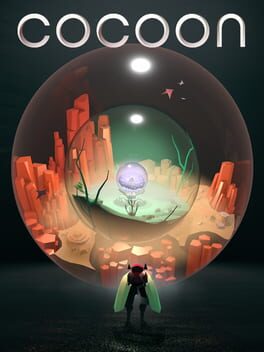thebestmark
2023
Cocoon is a ‘visual spectacle’ puzzle game in the Limbo and Inside lineage, with an inventive high concept: the game is built upon a series of discrete worlds which can be miniaturized and contained within one another like Russian nesting dolls. The player is cast as a kind of planet-stacking dung beety, ferrying swamp planets into forest planets into desert planets. Hopping inside of a world holding a different world in tow with the intention of taking something from that different world into an altogether third world is a fun parlor trick.
Cocoon didn’t do much for me beyond that. I like it fine enough, but it’s not a particularly thought-provoking experience. There is a compelling visual language at play, in which the sort of scale of the world vs. the scale of the bug-like player character are constantly at an inverse with their real-world equivalents, which calls to mind the way a game like Everything visually demonstrates that the microscopic world of bacteria is as infinitely vast as the macroscopic world of star systems. But Cocoon doesn’t develop beyond that in the way that a game like Inside does. Inside is initially as broad, but it reaches a conclusion, and in doing so is able to convey specific themes and ideas. Cocoon seems more interested in executing on the fundamentals of a puzzle game, but its puzzles aren’t particularly novel, and much of what the game has to offer is contained within the first hour of play.
It’s been gnawing at me that I must be missing something, considering all the high praise Cocoon has received. Cocoon cracked quite a few Game of the Year lists, but critics who’ve covered it don’t seem interested in exploring what the game is actually saying or doing. Most criticism I’ve read about Cocoon begin with superlatives about each major part of the game’s design and end with basic descriptions of how legible the game’s breadcrumbs are, how effortlessly it can lead the player towards the solutions to its problems, and how smart the player will feel once they’ve been made to solve those puzzles.
This last point, that Cocoon is supremely legible as a puzzle game, doesn’t necessarily do anything for me, in the abstract. In the broadest possible sense, I don’t think padding the ego of the player is a good instinct; it doesn’t produce an experience that matters. Puzzle games are not drugs that are supposed to make you feel smarter than you are, they’re interactive narrative objects like anything else, and pretending otherwise means you’re doing the game design equivalent of a Sudoku puzzle – or, if they are meant to give you a space where you can pretend you’re smart, then they’re meaningless. But hey, Myst made me feel incredibly stupid and I thought it was maybe the most interesting puzzle game I’d ever played, so, take what I say with a grain of salt, I guess.
The moment-to-moment gameplay of Cocoon is context-free video game stuff. Fighting boss battles with bomb-tossing spore-monsters and shepherding robots onto control pads doesn’t express very much about that macro-level part of the narrative. The reason why I prefer Inside, a game that’s functionally a predecessor to Cocoon, is that its imagery and mechanics told its story. The greyscale cubicle farm workplaces, the antagonistic security guards, the police dogs, the discovery of the mind control mechanic that enables the player to remake corpses into dutiful workers – all of these things paint a sharper picture of corporate dehumanization, layers of violence and domination disguised as a society. There is an emotional arc to that game, a reason to care about and to think about what you’re seeing and why you’re seeing it. Cocoon is a game that uses the core design tenants of something like Inside, it seems interested in producing that initial sense of intrigue, only to do less with more.
Cocoon didn’t do much for me beyond that. I like it fine enough, but it’s not a particularly thought-provoking experience. There is a compelling visual language at play, in which the sort of scale of the world vs. the scale of the bug-like player character are constantly at an inverse with their real-world equivalents, which calls to mind the way a game like Everything visually demonstrates that the microscopic world of bacteria is as infinitely vast as the macroscopic world of star systems. But Cocoon doesn’t develop beyond that in the way that a game like Inside does. Inside is initially as broad, but it reaches a conclusion, and in doing so is able to convey specific themes and ideas. Cocoon seems more interested in executing on the fundamentals of a puzzle game, but its puzzles aren’t particularly novel, and much of what the game has to offer is contained within the first hour of play.
It’s been gnawing at me that I must be missing something, considering all the high praise Cocoon has received. Cocoon cracked quite a few Game of the Year lists, but critics who’ve covered it don’t seem interested in exploring what the game is actually saying or doing. Most criticism I’ve read about Cocoon begin with superlatives about each major part of the game’s design and end with basic descriptions of how legible the game’s breadcrumbs are, how effortlessly it can lead the player towards the solutions to its problems, and how smart the player will feel once they’ve been made to solve those puzzles.
This last point, that Cocoon is supremely legible as a puzzle game, doesn’t necessarily do anything for me, in the abstract. In the broadest possible sense, I don’t think padding the ego of the player is a good instinct; it doesn’t produce an experience that matters. Puzzle games are not drugs that are supposed to make you feel smarter than you are, they’re interactive narrative objects like anything else, and pretending otherwise means you’re doing the game design equivalent of a Sudoku puzzle – or, if they are meant to give you a space where you can pretend you’re smart, then they’re meaningless. But hey, Myst made me feel incredibly stupid and I thought it was maybe the most interesting puzzle game I’d ever played, so, take what I say with a grain of salt, I guess.
The moment-to-moment gameplay of Cocoon is context-free video game stuff. Fighting boss battles with bomb-tossing spore-monsters and shepherding robots onto control pads doesn’t express very much about that macro-level part of the narrative. The reason why I prefer Inside, a game that’s functionally a predecessor to Cocoon, is that its imagery and mechanics told its story. The greyscale cubicle farm workplaces, the antagonistic security guards, the police dogs, the discovery of the mind control mechanic that enables the player to remake corpses into dutiful workers – all of these things paint a sharper picture of corporate dehumanization, layers of violence and domination disguised as a society. There is an emotional arc to that game, a reason to care about and to think about what you’re seeing and why you’re seeing it. Cocoon is a game that uses the core design tenants of something like Inside, it seems interested in producing that initial sense of intrigue, only to do less with more.
2023
Jusant is a meditative journey in which, entirely through climbing and exploration, the player traces a historiography of man-made ecological annihilation. In terms of tone and look, Jusant gives off the impression that it’s another post-Journey Journey-like (such as Abzu), but these similarities are superficial. Journey was a game that painted with a broad brush, using a storybook framework to go through the motions of an intentionally broad hero’s journey, whereas Jusant is all about the specifics of apocalypse. Besides all of the forgotten villages, artifacts and otherworldly wildlife the player encounters, there are also many abandoned letters, journals, advertisements and work orders to read; it would be more apt to say Jusant is like a hilariously vertical Gone Home, in which the heart of the game is contained in these little familiar documents, which are rendered otherworldly by the absence of the people who wrote them. And unlike other eschatologically-minded games like Fallout or Last of Us, Jusant’s characters, off-screen though they may be, are normal people under an imminent threat of annihilation, making bad choices in bad circumstances, pitiable and/or sympathetic as opposed to idiotically cruel and/or murderously evil. The game’s mechanics, which are centered around freeclimbing, necessitate careful observation of the game world, enhancing the player’s relationship with the narrative.
It also lets you travel the world with a fun little alien guy, which is always a plus.
It also lets you travel the world with a fun little alien guy, which is always a plus.

